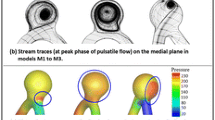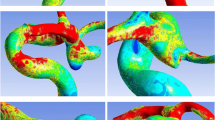Abstract
Introduction
This study was performed to assess the effect of aneurysm geometry on parameters that may have an impact on the natural history of intracranial aneurysms, such as intraaneurysmal flow pressure and shear stress.
Methods
Flow was simulated in 21 randomly selected aneurysms using finite volume modeling. Ten aneurysms were classified as side-wall aneurysms, with either single-sided or circumferential involvement of the parent artery wall, and 11 as bifurcation aneurysms (symmetric or asymmetric), with an axis either perpendicular or parallel to the parent artery. The flow patterns were classified as either jet or vortex types (with regular or irregular vortex flow). Pressures and shear stresses were characterized as evenly or unevenly distributed over the aneurysm wall and neck.
Results
All side-wall and four of the bifurcation aneurysms with a perpendicular axis had a vortex type flow pattern and seven bifurcation aneurysms with a parallel axis (four symmetric and two asymmetric) had a jet flow pattern. Jet type flow was associated with an uneven pressure distribution in seven out of seven aneurysms. Vortex type flow resulted in an even pressure distribution in five out of six aneurysms with an irregular flow pattern and six out of eight with a regular flow pattern. No firm relationship could be established between any geometrical type and shear stress distribution. Only 1 of 14 aneurysms with a perpendicular axis, but 4 of 7 aneurysms with a parallel axis, had ruptured.
Conclusion
Aneurysm geometry does have an impact on flow conditions. Aneurysms with a main axis parallel to the parent artery have a tendency to have a jet flow pattern and uneven distribution of unsteady pressure. These aneurysms may have a higher rate of rupture as than those with a main axis perpendicular to the parent artery.





Similar content being viewed by others
References
ISUIA Investigators (1998) Unruptured intracranial aneurysms – risk of rupture and risks of surgical intervention. International Study of Unruptured Intracranial Aneurysms Investigators. N Engl J Med 339(24):1725–1733
ISUIA Investigators (2003) Unruptured intracranial aneurysms: natural history, clinical outcome, and risks of surgical and endovascular treatment. Lancet 362:103–110
Graves VB et al (1992) Flow dynamics of lateral carotid artery aneurysms and their effects on coils and balloons: an experimental study in dogs. AJNR Am J Neuroradiol 13(1):189–196
Kerber CW et al (1996) Flow dynamics in a fatal aneurysm of the basilar artery. AJNR Am J Neuroradiol 17(8):1417–1421
Strother CM (1995) In vitro study of haemodynamics in a giant saccular aneurysm model: influence of flow dynamics in the parent vessel and effects of coil embolisation. Neuroradiology 37(2):159–161
Tateshima S et al (2001) Intraaneurysmal flow dynamics study featuring an acrylic aneurysm model manufactured using a computerized tomography angiogram as a mold. J Neurosurg 95(6):1020–1027
Valencia A (2004) Flow dynamics in models of intracranial terminal aneurysms. Mech Chem Biosyst 1(3):221–231
Valencia AA et al (2006) Blood flow dynamics in saccular aneurysm models of the basilar artery. J Biomech Eng 128(4):516–526
Foutrakis GN, Yonas H, Sclabassi RJ (1997) Finite element methods in the simulation and analysis of intracranial blood flow. Neurol Res 19(2):174–186
Chong BW et al (1994) Blood flow dynamics in the vertebrobasilar system: correlation of a transparent elastic model and MR angiography. AJNR Am J Neuroradiol 15(4):733–745
Jou LD et al (2003) Computational approach to quantifying hemodynamic forces in giant cerebral aneurysms. AJNR Am J Neuroradiol 24(9):1804–1810
Castro MA, Putman CM, Cebral JR (2006) Computational fluid dynamics modeling of intracranial aneurysms: effects of parent artery segmentation on intra-aneurysmal hemodynamics. AJNR Am J Neuroradiol 27(8):1703–1709
Cebral JR, Lohner R (2005) Efficient simulation of blood flow past complex endovascular devices using an adaptive embedding technique. IEEE Trans Med Imaging 24(4):468–476
Burleson AC, Strother CM, Turitto VT (1995) Computer modeling of intracranial saccular and lateral aneurysms for the study of their hemodynamics. Neurosurgery 37(4):774–782, discussion 782–784
San Millán Ruiz D et al (2006) The perianeurysmal environment: influence on saccular aneurysm shape and rupture. AJNR Am J Neuroradiol 27:504–512
Satoh T et al (2005) Influence of perianeurysmal environment on the deformation and bleb formation of the unruptured cerebral aneurysm: assessment with fusion imaging of 3D MR cisternography and 3D MR angiography. AJNR Am J Neuroradiol 26(8):2010–2018
Satoh T et al (2005) Visualization of aneurysmal contours and perianeurysmal environment with conventional and transparent 3D MR cisternography. AJNR Am J Neuroradiol 26(2):313–318
Hassan T et al (2005) A proposed parent vessel geometry-based categorization of saccular intracranial aneurysms: computational flow dynamics analysis of the risk factors for lesion rupture. J Neurosurg 103(4):662–680
Ujiie H et al (1999) Effects of size and shape (aspect ratio) on the hemodynamics of saccular aneurysms: a possible index for surgical treatment of intracranial aneurysms. Neurosurgery 45(1):119–129, discussion 129–130
Paal G et al (2007) Flow in simplified and real models of intracranial aneurysms. Int J Heat Fluid Flow 28:653–664
Cebral JR et al (2005) Characterization of cerebral aneurysms for assessing risk of rupture by using patient-specific computational hemodynamics models. AJNR Am J Neuroradiol 26(10):2550–2559
Cebral J (2007) Personalized computational modeling of stented cerebral aneurysms. Paper presented at the 4th International Intracranial Stent Meeting, Kyoto, Japan, 18–20 April 2007
Cebral JR et al (2005) Efficient pipeline for image-based patient-specific analysis of cerebral aneurysm hemodynamics: technique and sensitivity. IEEE Trans Med Imaging 24(4):457–467
Foutrakis GN, Yonas H, Sclabassi RJ (1999) Saccular aneurysm formation in curved and bifurcating arteries. AJNR Am J Neuroradiol 20(7):1309–1317
Kerber CW, Heilman CB (1983) Flow in experimental berry aneurysms: method and model. AJNR Am J Neuroradiol 4(3):374–377
Shojima M et al (2005) Role of the bloodstream impacting force and the local pressure elevation in the rupture of cerebral aneurysms. Stroke 36(9):1933–1938
Jou LD et al (2005) Correlation between lumenal geometry changes and hemodynamics in fusiform intracranial aneurysms. AJNR Am J Neuroradiol 26(9):2357–2363
Hassan T et al (2004) Computational replicas: anatomic reconstructions of cerebral vessels as volume numerical grids at three-dimensional angiography. AJNR Am J Neuroradiol 25(8):1356–1365
Shojima M et al (2004) Magnitude and role of wall shear stress on cerebral aneurysm: computational fluid dynamic study of 20 middle cerebral artery aneurysms. Stroke 35(11):2500–2505
Acknowledgements
This study was supported in part by a grant from the Hungarian National Science and Research Foundation (no. T 047150 OPR) and by research support from GE Amersham Healthcare Hungary.
Conflict of interest statement
We declare that we have no conflict of interest.
Author information
Authors and Affiliations
Corresponding author
Rights and permissions
About this article
Cite this article
Szikora, I., Paal, G., Ugron, A. et al. Impact of aneurysmal geometry on intraaneurysmal flow: a computerized flow simulation study. Neuroradiology 50, 411–421 (2008). https://doi.org/10.1007/s00234-007-0350-x
Received:
Accepted:
Published:
Issue Date:
DOI: https://doi.org/10.1007/s00234-007-0350-x




